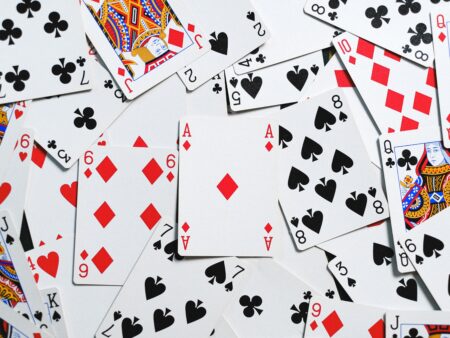Introduction
Most of you surely played poker for fun and used matches or some change. And it is highly likely that you played the most popular type of poker in England, that is „5 Card Draw Poker”. Truth is that people around the world choose also other variants of this game – it is advisable to get familiar with them.
Describing the following types of poker, we skipped details on the order of actions and rules applicable in bids (limits, orders, main and side pots, etc.). Here we just want to present you with the general rules of the game aimed at encouraging you to go into details and test yourself in the real game with other players.
For more details on particular games, please visit the website:
website
Texas Hold’em
It is undoubtedly the most popular, dynamic, and exciting type of poker. Many players consider it as the queen of pokers. Texas Hold’em is the primary game in prestigious tournaments, such as World Poker Tour (WPT) or World Series of Poker (WSOP). This is also the most popular variant of poker on the Internet.
Rules in Texas Hold’em are very simple. Every player receives two cards and keeps them secret. The first bid starts, players assess strength of their cards and decide to keep playing or fold. When bidding is finished, there is flop on the table, that is three cards facing down, common to all players. Another bid starts, the fourth community card (turn) shows up. Players start bidding again. When it is over, the remaining players see the last community card (river). Now the last bidding takes place.
To win, you need to have the strongest five-card hand, formed by community and private cards. The winning hand may include one private card or both cards. When the strongest hand is formed by community cards, cards received by players do not matter at all – the deal ends with a draw and players share the value of the pot.
Omaha
Omaha is a popular type of poker, similar to Texas Hold’em. Here you also need to use 52 cards. The first difference is that instead of two private cards, every player receives as many as four private cards. These cards remain invisible to opponents. Next the game progresses just like in Texas Hold’em (flop, turn, river and bidding between them). Another important difference between these two kinds of poker is the fact that the player needs to use exactly two private cards (and three from the table).
Omaha High/Low
Another kind of poker is the other variant of Omaha, that is Omaha High/Low. The principal difference between both variants is the fact that you can win even if you have the weakest hand. The principles of specifying the winner are relatively complicated and this is why this type of poker is recommended to those who have mastered Texas Hold’em and Omaha.
In Omaha High/Low the pot is divided when the winner is known, because it is possible to form both the strongest and weakest hand. A half of the pot is assigned to the player with the strongest hand, the other half goes to the one with the weakest hand. If nobody has the weakest hand, the highest hand takes everything. Similar to Omaha Poker, the player needs to use two cards from its hand and three cards from the table. You can use two different cards for the high or low hand.
The strongest hand is established in exactly the same way as in Omaha – the hierarchy rests on the standard table of poker hands. Forming a low hand is a bit more complicated, though. It must include eight or lower card, but cannot contain any pair. Importantly, street or suit cannot form a low hand, the exception is 5-4-3-2-A, which is the best lowest hand. It is also straight for the high hand. This is why you can win the entire pot with it.
7 Card Stud
Another very popular type of poker is 7 Card Stud. As opposed to four bids in Hold’em and Omaha, this variant offers as many as five rounds of bidding. Instead of a small and large blind, this game adopts a term – „ante” – which means the entry stake. This rate must be paid before the player receives its cards. Its value depends on the table limits, but usually is a percent of the lower limit.
In this type of poker, community cards facing up are not placed on the table, every player receives two cards facing down and one facing up, visible to other opponents. The player with the lowest uncovered card starts bidding by making the obligatory bet (bring-in). The bid starts in a clockwise direction, starting from the player on the left side to the one who brought in. Every player can fold, call or raise.
When all contestants make equal bets, they receive another card facing up (fourth street). The bidding starts from the player with the best hand from two cards facing up. It goes in a clockwise direction. If two players have the same pair, the bid starts from the one with the higher suit.
Next players receive the fifth uncovered card (fifth street) which initiates another bidding round. When it is over, another card is dealt, that is sixth street, and bidding starts again. The last card dealt to players is the seventh card which is not visible to others and remains facing down until the end of the bid. When the bid is finished, the player who ended it shows his hand composed of five out of seven cards. The best hand wins.
Please remember that in 7 Card Stud in some situations it is the hierarchy of suits that determines the final result. The strongest one is spades, followed by hearts, diamonds and clubs.
5 Card Draw
In Poland it is undoubtedly the most popular type of poker, and probably the easiest. The game involves up to five players, and each of them receives 5 cards. Every participant can exchange any number of cards once.
The game is based on the fixed order of events with two bidding stages. Two players to the left of the dealer post a small and big blind, similar to Texas Hold’em. Next, each player receives five cards facing down, invisible to others.
When cards are dealt, the first bidding round starts. When it is over, each player may reject and draw up to five new cards. The second round begins and ends when all bets are equaled by all players remaining in the game. Then cards are presented and hands compared, as a result of which the winner is revealed. 5 Card Draw also adopts a standard hierarchy of cards.







